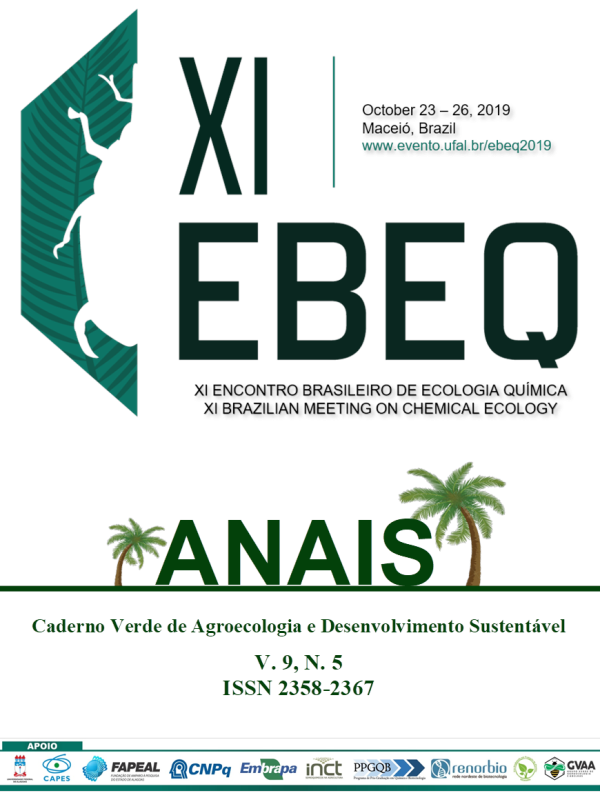RESPOSTA DE PARASITOIDES DE OVOS À POSSÍVEL SINERGIA ENTRE ESTÍMULOS QUÍMICOS E FÍSICOS
Palavras-chave:
COMPORTAMENTO, SINERGIA, INIMIGO NATURAL.Resumo
Os parasitoides de ovos da família Scelionidae são importantes agentes de controle biológico. Uma série de estímulos produzidos direta ou indiretamente por seus hospedeiros condicionam o comportamento de forrageamento desses insetos. No entanto, a interação e possível sinergia entre estímulos de diferente natureza são pouco conhecidas. Esse conhecimento é relevante para uma correta interpretação do comportamento de forrageamento de parasitoides, uma vez que, na natureza, esses estímulos não ocorrem isoladamente. Este trabalho teve como objetivo avaliar o comportamento de fêmeas do parasitoide de ovos Telenomus podisi Ashmead, 1893 (Hymenoptera: Scelionidae) em resposta a associação de estímulos de natureza química e física. Foram avaliados estímulos para os quais se tem conhecimento prévio da sua influência no comportamento dos parasitoides (atração). Os estímulos avaliados foram: (1) voláteis induzidos por herbivoria (VIH) de plantas de soja com injúria alimentar de Euschistus heros (Fabricius, 1798) (Hemiptera: Pentatomidae), (2) 2,6,10 trimetiltridecanoato de metila (componente do feromônio sexual de E. heros), (3) rastros químicos liberados no substrato por fêmeas de E. heros, (4) sinais vibratórios produzidos por fêmeas de E. heros, (5) e a cor amarela do substrato. Os experimentos foram realizados em arena de dupla escolha. No primeiro teste cada estímulo foi combinado com outro em um braço do olfatômetro versus o controle (braço da arena sem estímulos). No segundo teste, cada combinação de estímulos foi contrastada com cada um dos componentes da combinação separadamente. Os resultados do primeiro teste não indicam efeito sinérgico ou aditivo das combinações dos estímulos. No segundo teste, não foi observada diferença entre os tratamentos contrastados, exceto quando combinados os VIH e a cor versus os VIH. Os resultados sugerem que a combinação de estímulos de diferente natureza não modifica o comportamento do parasitoide. Propõe-se a hipótese de uso sequencial desses estímulos com uma possível potencialização da resposta do parasitoide após o contato com um estimulo prévio da sequência.Downloads
Publicado
Como Citar
Edição
Seção
Licença
Termo de cessão de direitos autorias
Esta é uma revista de acesso livre, em que, utiliza o termo de cessão seguindo a lei nº 9.610/1998, que altera, atualiza e consolida a legislação sobre direitos autorais no Brasil.
O(s) autor(es) doravante designado(s) CEDENTE, por meio desta, publica a OBRA no Caderno Verde de Agroecologia e Desenvolvimento Sustentável, representada pelo Grupo Verde de Agroecologia e Abelhas (GVAA), estabelecida na Rua Vicente Alves da Silva, 101, Bairro Petrópolis, Cidade de Pombal, Paraíba, Brasil. Caixa Postal 54 CEP 58840-000 doravante designada CESSIONÁRIA, nas condições descritas a seguir:
O CEDENTE declara que é (são) autor(es) e titular(es) da propriedade dos direitos autorais da OBRA submetida.
O CEDENTE declara que a OBRA não infringe direitos autorais e/ou outros direitos de propriedade de terceiros, que a divulgação de imagens (caso as mesmas existam) foi autorizada e que assume integral responsabilidade moral e/ou patrimonial, pelo seu conteúdo, perante terceiros.
O CEDENTE mantêm os direitos autorais e concedem à revista o direito de divulgação da OBRA, com o trabalho simultaneamente licenciado sob a Licença Creative Commons do tipo atribuição CC-BY.
O CEDENTE têm autorização para distribuição não-exclusiva da versão do trabalho publicada nesta revista.
O CEDENTE têm permissão e são estimulados a publicar e distribuir seu trabalho online (ex.: em repositórios institucionais ou na sua página pessoal) a qualquer ponto antes ou durante o processo editorial, já que isso pode gerar alterações produtivas, bem como aumentar o impacto e a citação do trabalho publicado.








